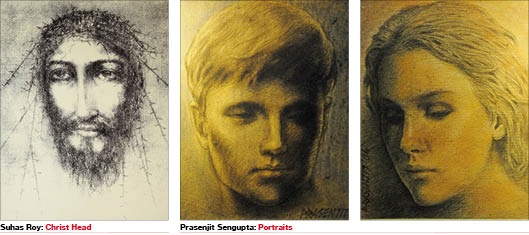In this auspicious Season of Shakti -- with ‘Maha-Shashthi’ heralding Durga Devi into our environment this weekend -- it is appropriate to review a collection called ‘Artists From Bengal’ – on display for the Durga Puja week until Oct. 22, at the HDFC Bank and Vatika Atrium on Golf Course Road. This timely Exhibition has been organised by Kolkata’s ‘Akar Prakar Gallery’, along with a group of young enterpreneurs called ‘Round Table India’ and HDFC Bank. The latter partnership—offering the bank premises to exhibit fine art—emphasises an increasing corporate awareness that Art is a covetable mode of investment, as well as an activity that lends immense social credibility, recognition and upward mobility to urban professionals and companies.
Fifteen artists from Bengal have been exhibited on a small scale, with small to medium-format works, in a quiet basement-space that was previously a gym at the HDFC premises. Evidently, the bank management felt that intellectual and cultural stimulation are more valuable assets on its premises than mere body-building! However, as this is only the 2nd art exhibition at this venue, a certain casualness of display is evidenced. Despite being small and secluded, the space has a fairly tasteful ambience, which could have been utilised to better effect.
This is a rather random collection of works of a few Kolkata thespians, who have been assembled alongside a smattering of paintings by younger, emerging Bengali artists. A wider, more reliable range of works, with greater curatorial focus, was expected from ‘Akar Prakar’. It includes interesting works by the late senior pioneers Dharmanarayan Dasgupta and Paritosh Sen. Individual pieces by current senior artists such as Suhas Roy, Sanat Kar, Sanjay Bhattacharya and Shuvaprasanna are juxtaposed with a set of recent works by Prasenjit Sengupta, Dharmapal, Debashish Das, Subroto Gangopadhyay, Beena Pradhan, Shipra Bhattacharya, Subir Dey and Mahajabin Majumdar.
The folksy water-colour painting by Dharmapal, at the entry to the show, strikes the current festive note, with its depiction of Ma Durga in red, carrying the infant Ganesha on her lap. Technically, however, this painting bears an evident Jamini Roy simulation. With a deceptively pleasing palette of reds and yellows, Dharmapal conveys just a touch of the Bengal-folk heritage. But he lacks the grace and
flow of Jamini Roy’s masterful and original artistic visualisations of the Kalighat Devis.

Paritosh Sen, the Picasso-inspired Kolkata Modernist, who passed away aged 90 in 2008, is represented by an interesting Mixed-media ‘Self-Portrait with Street-Dog’, as well as a pair of Limited Edition prints. The Self-Portrait contains a typically-Bengali pathos with a compassionate stance. Sen’s vibrant colour-palette is, however, not evidenced in any of the works.
The quirky magic-realism of Dharmanarayan Dasgupta is well conveyed in his amusingly vivid water-colour painting of a smiling Bengal Tiger suspended in flight, while carrying a framed profile-portrait of a Bhadralok-Lady.
Perhaps the finest works in this show are by the veteran Suhas Roy, and the younger Prasenjit. An extremely delicate, chiselled, graphic Suhas Roy ‘Christ Head,’ in a Limited Edition print, exemplifies this artist’s great sensitivity – with both emotions and linear skill. Roy’s piercingly realistic, transcendent gaze of Christ, wearing his burdenous crown of thorns, is both powerful and poignant.
Similarly, the small dyptich facial portraits of a young man and woman, by the 1964-born Prasenjit, are lucid and accomplished. Despite being acrylics on canvas, these naunced and poetic heads impressively convey the softness and subtlety of pencil or charcoal sketches. Another compelling paperwork is a sepia-toned water-colour of barbed-wire fences glinting in the afternoon sun, well-executed by the gifted Sanjay Bhattacharya.
By contrast, the more recent contemporary experiments of Mahajabin, Subir and Beena fall short – both in terms of emotional content and technical mastery. The ‘X-factor’ denoting all great art is always a certain ‘human connect.’ This must be combined with originality of vision, an evident technical finesse, and savoir-faire. Undue fiddling with textural details, or incongruous elements, always distracts from integral
aesthetic communications.

In future, delineation of a more careful selection of Bengali artists’ oeuvres and themes, in a reliable Catalog, would also be appreciated. Bengal Art has long been admired across the world for its emotional, intellectual, visceral and spiritual content, as well as for its advanced technical skills.
Evidently these are commercial times, resulting in an unfortunate ‘standardisation’ – even in art. I remain convinced, however, that Bengal’s radical fire remains hidden in the best of its more unassuming and quiet artistic ateliers --- awaiting further evolution, discovery
and analysis.
Read More...